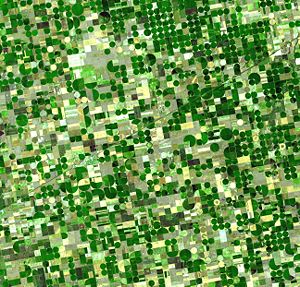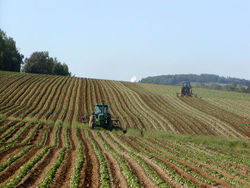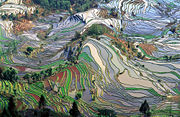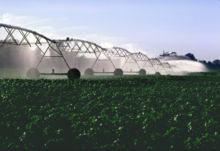Intensive farming
2008/9 Schools Wikipedia Selection. Related subjects: Agriculture; Environment
| Agriculture |
|---|
 |
| General |
| Agribusiness · Agriculture Agricultural science · Agronomy |
| History |
| History of agriculture Neolithic Revolution |
| Particular |
| Aquaculture · Christmas trees · Dairy farming Grazing · Hydroponics · IMTA |
| Categories |
| Agriculture by country Agriculture companies |
|
|
Intensive farming or intensive agriculture is an agricultural production system characterized by the high inputs of capital, fertilizers, labour, or labour-saving technologies such as pesticides relative to land area. This is in contrast to the concept of Extensive Agriculture which involves a low input of materials and labour with the crop yield depending largely on the naturally available soil fertility, water supply or other land qualities.
Modern day forms of intensive crop based agriculture involve the use of mechanical ploughing, chemical fertilizers, herbicides, fungicides, insecticides, plant growth regulators and/or pesticides. It is associated with the increasing use of agricultural mechanization, which have enabled a substantial increase in production.
Intensive animal farming practices can involve very large numbers of animals raised on limited land which require large amounts of food, water and medical inputs (required to keep the animals healthy in cramped conditions).. Very large or confined indoor intensive livestock operations (particularly descriptive of common US farming practices) are often referred to as Factory farming and are criticised by opponents for the low level of animal welfare standards and associated pollution and health issues.
Advantages
Intensive agriculture has a number of benefits:
- Significantly increased yield per available space than extensive farming.
- Often leads to cheaper priced products because of better general production rate for the cost of raw materials.
- Not much space for the animal(s) to move therefore less energy used up; so less food supplied to the cattle, which leads to cheaper products.
- Many people feel it's necessary to use intensive farming for better profits and economy
Disadvantages
Intensive farming alters the environment in many ways.
- Limits the natural habitat of some wild creatures and can lead to soil erosion.
- Use of fertilizers can alter the biology of rivers and lakes. Some environmentalists attribute the hypoxic zone in the Gulf of Mexico as being encouraged by nitrogen fertilization of the algae bloom.
- Pesticides can kill useful insects as well as those that destroy crops.
- Generally not sustainable.
- Often results in an inferior product.
- Use of chemicals on fields creates run-off, excess runs off into rivers and lakes causing pollution.
- Animal welfare is significantly decreased compared to organic, animals are kept in tight living conditions, over-fed and only have a small life span before being slaughtered
Pre modern intensive farming
Pre modern intensive farming techniques and structures include terracing, rice paddies, and various forms of aquaculture.
Oysters
"Oysters were likely the first sea animal to be transported from one area to another and cultivated as food. The ancient world, while knowing little about the reproduction of oysters, knew much about the conditions necessary for their growth. Pliny the Elder, a noted Roman naturalist of the first century, has left an account of artificial oyster beds established in Lake Lucrinus near Naples by a Sergius Orata about 95 B.C. Orata's methods consisted of preparing the grounds by removing other forms of marine life, planting seed oysters, cultivating the oysters by keeping them separated in order to grow to a well-formed, mature size, and finally harvesting them when they were ready for market. Modern oyster farming, based on the knowledge of oyster biology, basically follows the Roman procedure.Fisheries and Oceans Canada] article American Oyster
Terrace
In agriculture, a terrace is a leveled section of a hilly cultivated area, designed as a method of soil conservation to slow or prevent the rapid surface runoff of irrigation water. Often such land is formed into multiple terraces, giving a stepped appearance. The human landscapes of rice cultivation in terraces that follow the natural contours of the escarpments like contour ploughing is a classic feature of the island of Bali and the Banaue Rice Terraces in Benguet, Philippines. In Peru, the Inca made use of otherwise unusable slopes by drystone walling to create terraces.
Rice paddy
A paddy field is a flooded parcel of arable land used for growing rice and other semiaquatic crops. Paddy fields are a typical feature of rice-growing countries of east and southeast Asia including Malaysia, China, Sri Lanka, Myanmar, Thailand, Korea, Japan, Vietnam, Taiwan, Indonesia, India, and the Philippines. They are also found in other rice-growing regions such as Piedmont (Italy), the Camargue (France) and the Artibonite Valley (Haiti). They can occur naturally along rivers or marshes, or can be constructed, even on hillsides, often with much labour and materials. They require large quantities of water for irrigation, which can be quite complex for a highly developed system of paddy fields. Flooding provides water essential to the growth of the crop. It also gives an environment favourable to the strain of rice being grown, and is hostile to many species of weeds. As the only draft animal species which is adapted for life in wetlands, the water buffalo is in widespread use in Asian rice paddies. There are significant adverse environmental impacts from rice paddy cultivation due to the generation of large quantities of methane gas. World methane production due to rice paddies has been estimated in the range of 50 to 100 million tonnes per annum; this level of greenhouse gas generation is a large component of the global warming threat and derives simply from an expanding human population.
Rice-farming and the use of paddies in Korea is ancient. Korean paddy-farming can provide cultural background on the use of paddies in East Asia. A pit-house at the Daecheon-ni site yielded carbonized rice grains and radiocarbon dates indicating that rice cultivation may have begun as early as the Middle Jeulmun Pottery Period (c. 3500-2000 B.C.) in the Korean Peninsula (Crawford and Lee 2003). The earliest rice cultivation in the Korean Peninsula may have used dry-fields instead of paddies.
The earliest Mumun features were usually located in low-lying narrow gulleys that were naturally swampy and fed by the local stream system. Some Mumun paddies in flat areas were made of a series of squares and rectangles separated by bunds approximately 10 cm in height, while terraced paddies consisted of long irregularly shapes that followed natural contours of the land at various levels (Bale 2001; Kwak 2001).
Mumun Period rice farmers used all of the elements that are present in today's paddies such terracing, bunds, canals, and small reservoirs. We can grasp some paddy-farming techniques of the Middle Mumun (c. 850-550 B.C.) from the well-preserved wooden tools excavated from archaeological rice paddies at the Majeon-ni Site. However, iron tools for paddy-farming were not introduced until sometime after 200 B.C. The spatial scale of individual paddies, and thus entire paddy-fields, increased with the regular use of iron tools in the Three Kingdoms of Korea Period (c. A.D. 300/400-668).
French Intensive Horticulture
Modern intensive farming types
Modern intensive farming refers to the industrialized production of animals (livestock, poultry and fish) and crops. The methods deployed are designed to produce the highest output at the lowest cost; usually using economies of scale, modern machinery, modern medicine, and global trade for financing, purchases and sales. The practice is widespread in developed nations, and most of the meat, dairy, eggs, and crops available in supermarkets are produced in this manner.
Sustainable intensive farming
Biointensive agriculture focuses on maximizing efficiency: yield per unit area, yield per energy input, yield per water input, etc. Agroforestry combines agriculture and orchard/forestry technologies to create more integrated, diverse, productive, profitable, healthy and sustainable land-use systems. Intercropping can also increase total yields per unit of area or reduce inputs to achieve the same, and thus represents (potentially sustainable) agricultural intensification. Unfortunately, yields of any specific crop often diminish and the change can present new challenges to farmers relying on modern farming equipment which is best suited to monoculture.
Intensive aquaculture
Aquaculture is the cultivation of the natural produce of water (fish, shellfish, algae, seaweed and other aquatic organisms). Intensive Aquaculture can often involve tanks or other highly controlled systems which are designed to boost production for the available volume or area of water resource.
Intensive livestock farming
The modern examples of intensive farming are broadly referred to as Concentrated Animal Feeding Operations (CAFOs) or often termed Factory farming. These include:
Managed intensive grazing
This sustainable intensive livestock management system is increasingly used to optimize production within a sustainability framework and is generally not considered Factory farming.
Individual industrial agriculture farm
Major challenges and issues faced by individual industrial agriculture farms include:
- integrated farming systems
- crop sequencing
- water use efficiency
- nutrient audits
- herbicide resistance
- financial instruments (such as futures and options)
- collect and understand own farm information;
- knowing your products
- knowing your markets
- knowing your customers
- satisfying customer needs
- securing an acceptable profit margin
- cost of servicing debt;
- ability to earn and access off-farm income;
- management of machinery and stewardship investments.
Integrated farming systems
An integrated farming system is a progressive biologically integrated sustainable agriculture system such as Integrated Multi-Trophic Aquaculture or Zero waste agriculture whose implementation requires exacting knowledge of the interactions of numerous species and whose benefits include sustainability and increased profitability.
Elements of this integration can include:
- intentionally introducing flowering plants into agricultural ecosystems to increase pollen-and nectar-resources required by natural enemies of insect pests
- using crop rotation and cover crops to suppress nematodes in potatoes
Crop sequencing

Crop rotation or crop sequencing is the practice of growing a series of dissimilar types of crops in the same space in sequential seasons for various benefits such as to avoid the build up of pathogens and pests that often occurs when one species is continuously cropped. Crop rotation also seeks to balance the fertility demands of various crops to avoid excessive depletion of soil nutrients. A traditional component of crop rotation is the replenishment of nitrogen through the use of green manure in sequence with cereals and other crops. It is one component of polyculture. Crop rotation can also improve soil structure and fertility by alternating deep-rooted and shallow-rooted plants.
Water use efficiency
Crop irrigation accounts for 70% of the world's fresh water use. The agricultural sector of most countries is important both economically and politically, and water subsidies are common. Conservation advocates have urged removal of all subsidies to force farmers to grow more water-efficient crops and adopt less wasteful irrigation techniques.
For crop irrigation and plant irrigation, optimal water efficiency means minimizing losses due to evaporation or runoff. An evaporation pan can be used to determine how much water is required to irrigate the land. Flood irrigation, the oldest and most common type, is often very uneven in distribution, as parts of a field may receive excess water in order to deliver sufficient quantities to other parts. Overhead irrigation, using centre-pivot or lateral-moving sprinklers, gives a much more equal and controlled distribution pattern, but in extremely dry conditions much of the water may evaporate before it reaches the ground. Drip irrigation is the most expensive and least-used type, but offers the best results in delivering water to plant roots with minimal losses.
As changing irrigation systems can be a costly undertaking, conservation efforts often concentrate on maximizing the efficiency of the existing system. This may include chiseling compacted soils, creating furrow dikes to prevent runoff, and using soil moisture and rainfall sensors to optimize irrigation schedules.
Water catchment management measures include recharge pits, which capture rainwater and runoff and use it to recharge ground water supplies. This helps in the formation of ground water wells etc. and eventually reduces soil erosion caused due to running water.
Nutrient audits
Better nutrient audits allow farmers to spend less money on nutrients and to create less pollution since less nutrient is added to the soil and thus there is less to run off and pollute. Methodologies for assessing soil nutrient balances have been studied and used for farms and entire countries for decades. But at present "there is no standard methodology for calculating nutrient budgets and there are no accepted 'benchmarks' figures against which to assess farm nutrient use efficiency. [A standard methodology] for calculating nutrient budgets on farms [is hoped to help reduce] diffuse water and air pollution from agriculture [through] best management practices in the use of fertilisers and organic manures, as part of the continued development of economically and environmentally sustainable farming systems."
Herbicide resistance
In agriculture large scale and systematic weeding is usually required, often performed by machines such as cultivators or liquid herbicide sprayers. Selective herbicides kill specific targets while leaving the desired crop relatively unharmed. Some of these act by interfering with the growth of the weed and are often based on plant hormones. Weed control through herbicide is made more difficult when the weeds become resistant to the herbicide. Solutions include:
- using cover crops (especially those with allelopathic properties) that out-compete weeds and/or inhibit their regeneration.
- using a different herbicide
- using a different crop (e.g. genetically altered to be herbicide resistant; which ironically can create herbicide resistant weeds through horizontal gene transfer)
- using a different variety (e.g. locally-adapted variety that resists, tolerates, or even out-competes weeds)
- ploughing
- ground cover such as mulch or plastic
- manual removal


